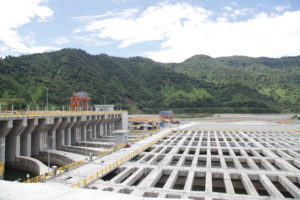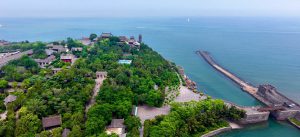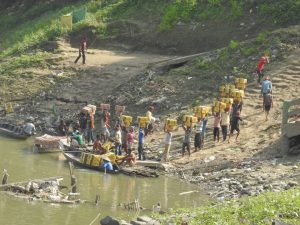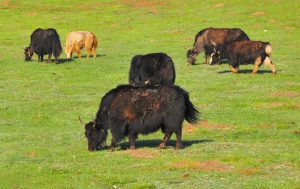Nearly a thousand people have been killed by floods in Nepal, Bihar, West Bengal and Assam in India, and in Bangladesh. Almost all of southern and interior western India is grappling with water scarcity, with mega-city Chennai being supplied by water trains, one woman in Srikakulam district of Andhra Pradesh killing another at a water queue. Women elsewhere in the state have been blockading a highway because they have not had drinking water for a week.
Meanwhile the Indian states of Bihar, West Bengal, and the northeastern states, as well as the neighbouring country of Bangladesh, are experiencing massive floods. In Assam, the Brahmaputra has flooded 95% of the Kaziranga National Park – home of the one-horned rhino and a World Heritage Site. The road link between north-eastern India and the rest of the country is flooded.
All 56 gates of the barrage on the Kosi river at the India-Nepal border have been opened to prevent catastrophe. The result is floods engulfing all of north-eastern Bihar in downstream India.
The June-September monsoon that brings 80% of the annual rainfall to South Asia is running late and has now stalled. About half of India’s 600 million farmers have not been able to sow their main crop of the year – they do not have irrigation facilities and are dependent on rain. Official figures compiled by the central agriculture ministry show a 33% deficit in sowing.
Aurangabad in the Marathwada region of Maharashtra, western India, is reporting that water reservoirs are 99.7% empty.
The monsoon is not scheduled to reach Pakistan yet, but with contiguous parts of India – Punjab and Rajasthan – reporting tardy rainfall, alarm bells have started to ring. Authorities in Pakistan are reporting that water reservoirs in southern Punjab and Sindh are almost dry.
In Chennai, despite the arrival of two water trains with much fanfare, over 30% of the six million residents are seeing water in community taps only once in three days, not to talk of water reaching home. Night-long queues at these taps have become a must.
In smaller cities throughout southern, western and central India, municipal water supply has almost collapsed. Eastern India is not facing such a scarcity of water for domestic use, but farmers in semi-arid regions – such as Purulia and Birbhum districts of West Bengal and adjoining areas in Jharkhand – are looking at crop failure as the rainfall remains scanty. Managers at thermal power stations in Jharkhand are contemplating forced closure for a time, since there is almost no water to wash the coal before use.
At the same time, relief centres for flood-displaced people are being opened throughout southern Nepal, north-eastern Bihar, the Alipurduar region in West Bengal and all along the Brahmaputra valley in Assam. At last count, over seven million people had been displaced.
Not just humans
In many ways, Kaziranga National Park shows the plight of both people and animals during the current flood. Hundreds of vehicles are stranded on National Highway 37, which connects north-eastern India to western Assam and the rest of the country. Park rangers are working round the clock to let vehicles alternately drive through a narrow stretch above the floodwaters, and closing the road so that animals can cross to the safety of the Karbi Anglong hills on the south.
The Brahmaputra – which flows along the northern end of the forest – crossed the danger mark on July 13. Elephants, buffaloes, rhinos, deer, wild boar were all seen crossing the highway. Over a dozen hog deer were run down by speeding vehicles, said a ranger, adding that there could be no full count of the animals drowned until the floodwaters receded. In the meanwhile Rohini Ballav Saikia, the Divisional Forest Officer in charge of Kaziranga, today confirmed the recovery of a dead rhino in the Agaratoli Range that took the toll to 4 rhinos till now. There have been news of elephant calves being washed away and the death of a Royal Bengal tiger and hundreds of hog deer due to drowning.

The Assam government warns that the situation may worsen, as more rain is predicted. “The flood situation remains extremely critical,” stated Assam’s Water Resources Minister Keshab Mahanta. All the major tributaries of the Brahmaputra have also breached their danger levels. Over 3,000 villages are inundated, and over 17,000 people forced to take refuge in 327 relief camps, according to the State Disaster Management Authority. Over 87,000 hectares of farmland is submerged.
Kaziranga is flooded almost every year – in fact, it is part of the Brahmaputra floodplain. Plants and animals are adapted to it, and the grasslands that form every autumn when the floodwaters recede provide essential food to animals. That is why Kaziranga hosts two-thirds of the world’s Great One-horned Rhinoceroses and boasts the highest density of tigers among protected areas in the world.
“Flood flushes out the aquatic weeds that would otherwise choke the water bodies and rejuvenates it every year. In fact, we were a bit worried when Kaziranga was going without flood last year,” said Akashdeep Baruah, who has recently left KNP as its director to become Assam’s Principal Chief Conservator of Forests.
The problem is that these floods are now massive, with longer periods of drought as well. Over 550 animal deaths were officially recorded in the 2012 floods; unofficial estimates cross 1,000. Another 350-odd animals, including 26 rhinos, five elephants and a tiger were killed due to floods in 2017.
Apart from the deaths by drowning and being run over while crossing the highway, animals are in danger because they are concentrated in a much smaller area, making it easier for poachers. When the floodwaters receded in 2017, rhino carcasses were found with their horns hacked off. The horns are smuggled to China here they fetch astronomical prices due to the mistaken belief that they increase potency.
Climate change leads to uncertainty
The uncertainty that is affecting people around Kaziranga and animals within is also affecting South Asia as a whole. The Intergovernmental Panel on Climate Change had predicted in 2011 that climate change would lead to fewer rainy days but heavier rainfall on those days. The entire subcontinent is now proving the accuracy of that forecast.
Policymakers in various South Asian countries have shown few signs of being able to deal with this new normal, though the Indian government has recently declared that revival of traditional water harvesting will be its flagship scheme over the next five years. That programme has just started. The results remain to be seen.
![<p>A freight train loaded down with water leaves for the Indian city of Chennai [image by: DNA]</p>](https://dialogue.earth/content/uploads/2019/07/water_train_for_Chennai_July_2019-1.jpg)







